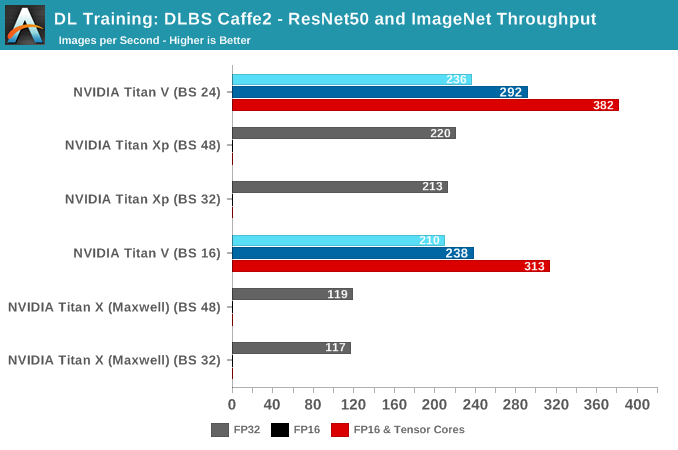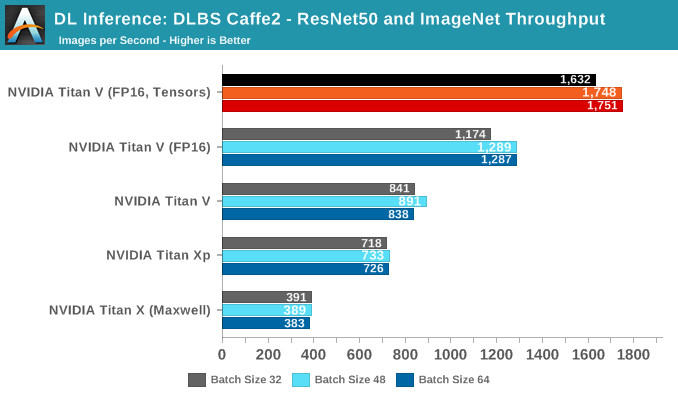The NVIDIA Titan V Deep Learning Deep Dive: It's All About The Tensor Cores
by Nate Oh on July 3, 2018 10:15 AM ESTHPE DLBS, Caffe2: ResNet50 and ImageNet
On that relevant note, we'll take a look at HPE Deep Learning Benchmark Suite, part of their Deep Learning Cookbook. With a different angle than usual DL benchmark suites, its wide-ranging test-running modularity lends itself to quickly diagnose issues or bottlenecks on hardware platforms, which would be useful for an organization like HPE. Focused mostly on NVIDIA GPUs running computer vision CNNs, the DLBS setup is Volta-aware and is essentially outputs throughput and time metrics only, with some advanced monitoring and visualization tools that are only somewhat user-friendly.
For our purposes, it allows us to corroborate the NVIDIA Caffe2 Docker benchmark, so we train and inference with a ResNet50 model on ImageNet. But as the models and implementations are different, these throughput numbers shouldn't be directly compared to NVIDIA's Caffe2 Docker test.

During the training benchmarking, certain batch sizes for Titan V refused to run, but generally, we see the same trend as before, with FP16 and tensor cores providing higher throughput.
We see the same trends continue with inferencing. Unfortunately, the DLBS Caffe2 test does not seem to support INT8 inferencing.











65 Comments
View All Comments
SirCanealot - Tuesday, July 3, 2018 - link
No overclocking benchmarks. WAT. ¬_¬ (/s)Thanks for the awesome, interesting write up as usual!
Chaitanya - Tuesday, July 3, 2018 - link
This is more of an enterprise product for consumers so even if overclocking it enabled its something that targeted demographic is not going to use.Samus - Tuesday, July 3, 2018 - link
woooooooshMrSpadge - Tuesday, July 3, 2018 - link
He even put the "end sarcasm" tag (/s) to point out this was a joke.Ticotoo - Tuesday, July 3, 2018 - link
Where oh where are the MacOS drivers? It took 6 months to get the pascal Titan drivers.Hopefully soon
cwolf78 - Tuesday, July 3, 2018 - link
Nobody cares? I wouldn't be surprised if support gets dropped at some point. MacOS isn't exactly going anywhere.eek2121 - Tuesday, July 3, 2018 - link
Quite a few developers and professionals use Macs. Also college students. By manufacturer market share Apple probably has the biggest share, if not then definitely in the top 5.mode_13h - Tuesday, July 3, 2018 - link
I doubt it. Linux rules the cloud, and that's where all the real horsepower is at. Lately, anyone serious about deep learning is using Nvidia on Linux. It's only 2nd-teir players, like AMD and Intel, who really stand anything to gain by supporting niche platforms like Macs and maybe even Windows/Azure.Once upon a time, Apple actually made a rackmount OS X server. I think that line has long since died off.
Freakie - Wednesday, July 4, 2018 - link
Lol, those developers and professionals use their Macs to remote in to their compute servers, not to do any of the number crunching with.The idea of using a personal computer for anything except writing and debugging code is next to unheard of in an environment that requires the kind of power that these GPUs are meant to output. The machine they use for the actual computations are 99.5% of the time, a dedicated server used for nothing but to complete heavy compute tasks, usually with no graphical interface, just straight command-line.
philehidiot - Wednesday, July 4, 2018 - link
If it's just a command line why bother with a GPU like this? Surely integrated graphics would do?(Even though this is a joke, I'm not sure I can bear the humiliation of pressing "submit")